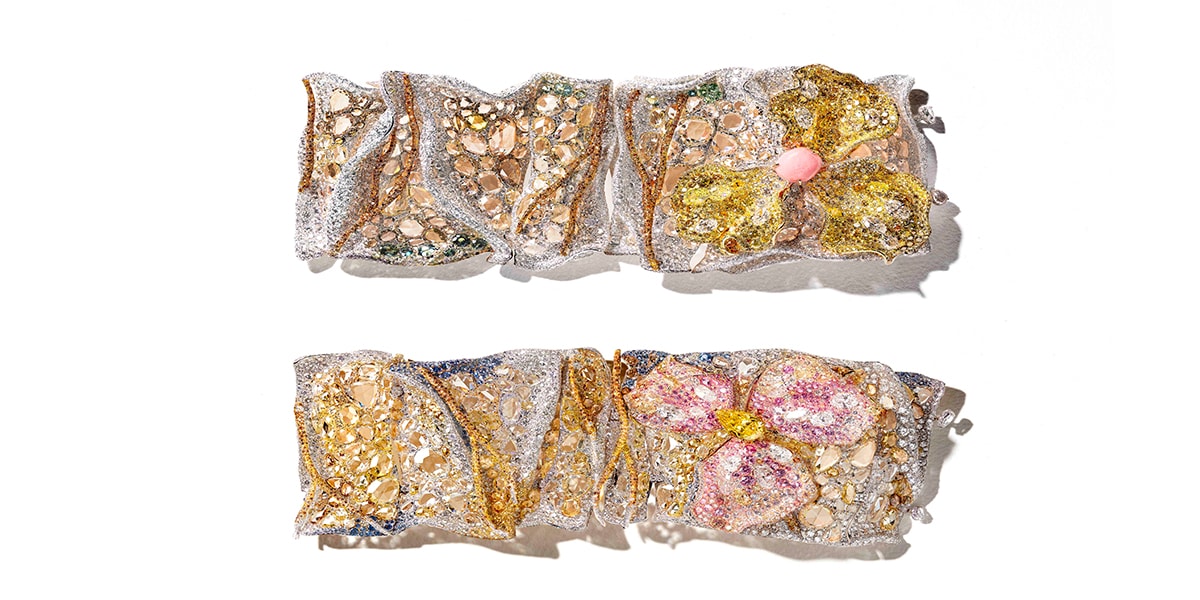Cindy Chao, renowned jewellery designer, has revolutionised the way fine jewellery is created and perceived thanks to her background in architecture and sculpture. Cindy learned the various techniques and skills of sculpting from her father who is a sculptor. Her grandfather was a distinguished architect who designed hundreds of temples across Taiwan, many of which are now considered national monuments.
Your upbringing was immersed in an extraordinary and vibrant creative environment. What did you learn under your father and grandfather’s guidance?
This is a less known story but actually my grandfather had an important role helping me develop high sensitivity to colour graduations. In my childhood, he often brought me to his construction sites. In addition to talking about the space and structures, he showed me the art of toning to create a palette of colours with subtle nuances. Back in those days, technology could not be relied on and I could not tell any differences with my naked eye at the beginning. However he insisted so much and tried repeatedly until he found the correct colour that he was going to use on a specific column. Colour and structure are therefore the two key elements in my work.
Can you tell us more about the process of creating your jewels?
I am a perfectionist and I always challenge myself to the utmost. Every time when I craft my jewels starting with wax sculpting, I pay attention to even the tiniest structural details in order to portray the lifelike contour. I then use a wide range of gems, of heterogeneous hues and sizes, to depict the appearance true to nature. The process of repetitive verification and modification can take months to years. Every piece must attain my perfection standard without any structural, visual or aesthetical flaw before it can be confirmed completed. However, once the work is done, I immediately pose myself the question: how can I improve my jewel, whether technically or aesthetically, to bring it to a higher level next time? Then I feel the excitement to carry out another creation by setting for myself a series of challenges, aiming to bring my work even closer to perfection.
Are the bangle series, the 2019 Black Label Masterpiece VI “Scultura di Giglio Bangle” and the 2019 Black Label Masterpiece XI “Solstice Sculptural Bangle” (in the images accompanying this piece), the milestone pieces as your brand is about to embrace its 15th anniversary?
It best translates my vision to create high jewellery as pieces of miniature sculpture or architecture using a wide range of colour spectrum. In terms of the shape, both bangles are ultra-organic with their surface delicately sculpted using CINDY CHAO’s signature wax sculpting approach. This ancient technique, once widespread in eighteenth century Europe, allows me to conceive a three-dimensional wax model in one-to-one scale to the final art jewel, with each undulation and curve precisely carved on the wax sculpture. Mechanism-wise, the bangles are composed of several leaf-like components, which are put together through flexible joints conceived for six years. This particular construction allows for the bangles to be able to spread flat like a canvas, on which I can do oil painting using an abundant smattering of coloured gems, from yellow, orange and brown, to pink, blue and green. These gemstones come in a wide variety of cuts and in turn feed the sculptural style.
The Hong Kong Jewellery and Gem Fair, the world’s leading jewellery fair, is fast approaching, can you see any significant trends in high jewellery?
Fashion trends are always fun and exciting as we can expect something new that adds spice to our lives. Jewellery, although able to reflect different fashion styles of each period (from Art Nouveau in 1910s to Hollywood Glamour in 1930s to what is now contemporary jewellery), are however less prone to trend. One reason may be that jewellery pieces, which consist of precious gems and metal, are generally made to last for a much longer time, even as heirlooms that are passed down from generation to generation. One particular trend I have noticed in recent years is that some Asian connoisseurs who used to lay more emphasize on mega brands and gem sizes are now developing taste for artistry and interest in unique brands. In addition to the traditionally worshipped carat weight, they have started to understand and appreciate critical elements such as craftsmanship, the brand, or the artist’s history and their future potential.
What is the current state of the Asian high jewellery market?
The landscape of jewellery design and demographic of collectors has changed in the past two decades. When I first started my brand, there were not a lot of people who understood my definition of “art jewels”, especially in Asia. In the past 15 years, the world has changed so quickly and people are getting new information at their fingertips by the second. With everything else being fast and automated, collectors nowadays treasure craftsmanship that takes time to refine, and memorable experiences that could be savoured. As Asia has been on the rise of its economic power, the western market has been more interested in eastern aesthetic and preference. Meanwhile, in addition to big jewellery houses with century-old history, globally there are more and more independent creators challenging the limit of jewellery design. Among these individual creators we see a large number of them emerging with an Asian heritage. By bringing their unique insight and tastes to their works, they enrich the landscape of the industry which is traditionally dominated by European brands.
Cindy Chao will share her experience with Christie’s Education students on the Bringing Gems to Life course taking place from 16-17 September in Hong Kong.

